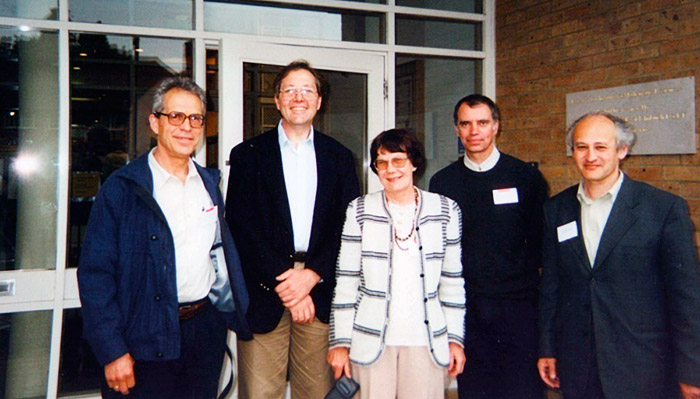
Electronic english version since 2022 |
The newspaper was founded in November 1957
| |
Their names are in the history of the Institute
Varied and fruitful cooperation
Traditionally, BLTP theoretical physicists involved in condensed matter have widely cooperated with FLNP experimental physicists and this cooperation has been very diverse: participation in seminars, trips to neutron conferences, joint analysis of experimental data, others.
We can recall the lectures by V.L.Aksenov, N.M.Plakida and V.B.Priezzhev at the Neutron Schools in Alushta; direct participation of V.A.Zagrebnov and V.B.Priezzhev in the development of a strategy for processing and analysis of the data on Bose condensation in liquid helium-4 obtained in FLNP, a considerable number of joint publications. In the 1970s and 1980s, the staff members of the Department of Condensed Matter Theory of BLTP annually came to FLNP with a report on the work implemented during the year and visited the experimental hall of the pulsed neutron source with interest, where they were told about new capabilities of neutron spectrometers.
N.M.Plakida was always one of the most active participants in this process. He showed interest in our work on compounds with high proton conductivity. This interesting and practically significant phenomenon was discovered at the Institute of Crystallography of the Russian Academy of Sciences, in the laboratory of L.A.Shuvalov, in the early 1980s. At that time, the cooperation between IC RAS and FLNP JINR had already been developed and mainly concerned various aspects of the organization of the domain structure of some ferroelectrics and ferroelastics, as well as the impact of external fields on it. L.A.Shuvalov was enthusiastic about using a method new to him - thermal neutron scattering for studying dielectrics and when it was found that a previously unknown state with a high proton conductivity occurred in cesium sulfate and selenate crystals at temperatures close to 400 K, he proposed to deal with this topic. It took a couple of years to understand the sequence of structural phases and to determine their crystallographic characteristics. These data turned out to be sufficient for N.M.Plakida to propose a model of the superprotonic phase transition in these crystals, the main conclusions of which were corresponded well to the experiment.

BLTP theorists at IBR-2 (early 1980s). Yu.M.Ostanevich gives explanations.
In the mid-1980s, a landmark event took place in Condensed matter physics - high-temperature superconductivity (HTSC) was discovered in cuprates. The transition temperature was about 95 K in complex yttrium oxide (1987) and in mercury oxides, first synthesized in E.V.Antipov's Laboratory at the Chemistry Department of Moscow State University in the early 1990s, it reached 135 K. This discovery was followed by an unprecedented explosion of scientific activity, both experimental and theoretical, that was why N.M.Plakida could not stand aside. He managed to develop an original model that although not yet generally accepted, is noted as a significant contribution to the solution of this most difficult problem. The apogee of his activity was writing and publishing the monographs of the landmark book High-Temperature Cuprate Superconductors (570 pages, 161 figures, 1440 references) in the Springer series in 2010. There is no doubt that this book will be a reference book for many, many solid-state physicists for a long time.
In the mid-1990s, another event took place in Condensed matter physics, not as epochal as HTSC, but that strongly excited the solid-state community. In very simple compounds, mixed oxides of manganese, the effect of colossal magnetoresistance (CMR) was discovered. It consisted in the following: the electrical resistance of the oxide changed by several orders of magnitude when it was placed in an external magnetic field. Like HTSC, the effect was unexpected, extremely interesting from a physical point of view and very promising for a variety of technological applications. In those years, international scientific projects (INTAS), funded by the European Union, were very popular. The competition was very high, but we managed to assemble a wonderful team, including employees of FLNP, BLTP (N.M.Plakida), NRC KI and MSU and agreed with a very respected professor from Cambridge Peter Littlewood on the coordination of work. The project was carried out from November 1998 to April 2001 and was extremely successful. N.M.Plakida played a very important role in the success of the project, he participated in all numerous discussions, was a co-author of most of the published papers and presented his model of the isotopic (oxygen) effect observed in some compositions.

Participants of the INTAS project "Spin, charge and orbital ordering in complex magnetic oxides":
N.M.Plakida, N.A.Babushkina, A.M.Balagurov and K.I.Kugel with Professor P.Littlewood during a visit to Cambridge.
We have recalled only a few important episodes of the participation of N.M.Plakida in the scientific life of FLNP. Of course, our cooperation was harmoniously supplemented by numerous informal meetings, during which interesting physical issues were almost always raised, talking about physics for Nikolay Maksimilianovich was the main pleasure in life.
Anatoly BALAGUROV